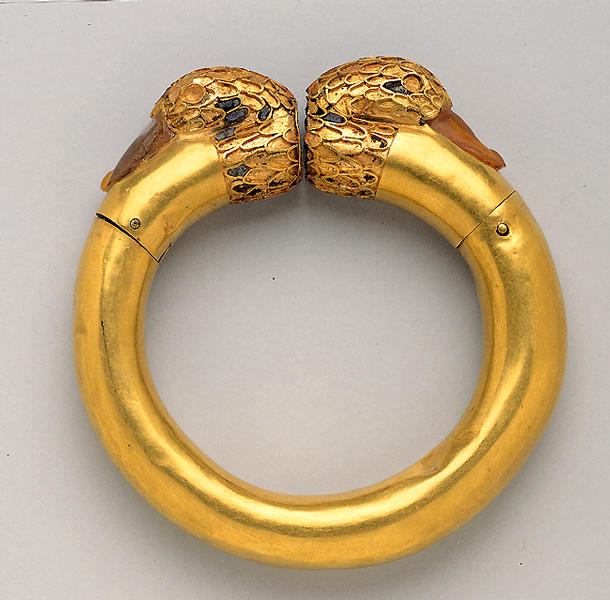Bracelet with Duck's-head Terminals
- Iran
- Persia, Achaemenid period
- Mid-6th to 4th centuries B.C.
- Gold with lapis lazuli, agate, and carnelian
- H-8.3 D-1.4 W-8
Catalogue Entry
The massive bracelet is more or less a smaller, simplified version of catalogue number 40. The ducks are reduced to protomes with their heads turned back in a typical Achaemenid fashion.1 The bracelet is constructed of hollow gold tubing, and the duck protomes were formerly elaborately inlayed with colored stones. One duck bill is made of agate, the other of carnelian.2 The ducks were both made separately and were in all likelihood originally joined together at their breasts. In order to put on the bracelet, the birds could be separated from the circlet by removing the rivets.
The bracelet type is preserved in much simpler versions of bronze or golden wire,3 and details like the turned heads resting on the animals' backs seem truly Achaemenid, but a certain naturalistic tendency, already noted in connection with catalogue number 40, along with the concept of a removable part may point to a later period and attribute our piece to the circle of Achaemenizing art fashioned in the Hellenistic period.4 It must be stressed, however, that at the moment, this is nothing but a hypothesis.
MP
1. See cat. no. 40, n.4.
2. For the question of authenticity of the bills see the technical note in Metropolitan Museum 1996, p. 187.
3. Musche 1992, pls. 97.2; 113.1,1; Arne 1962, p. 15, fig. 14 (possibly from Luristan). A golden bracelet of alleged "Amlash-provenance" in Teheran: Maxwell-Hyslop 1971, p. 205, pl. 161. Especially worth noting is a pair thin of bronze bracelets from Bard-i Bal (Iran) that have complete animals with turned-back heads: Iranica Antiqua 1973, pl. 21. The turned heads likewise occur on two bracelets of thick gold wire from the Oxus treasure in London, British Museum: Dalton 1969, p. 38, no. 142, pl. 19. For the problematic chronology of this treasure see Pfrommer 1990b, pp. 121-23.
4. See cat. no. 40, n.7.
